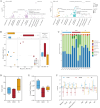Fufang Taizishen Granules Attenuate Chemotherapy-Induced Intestinal Mucositis by Modulating Gut Microbiota and Amino Acid Metabolism
- PMID: 40801049
- PMCID: PMC12339415
- DOI: 10.1002/fsn3.70789
Fufang Taizishen Granules Attenuate Chemotherapy-Induced Intestinal Mucositis by Modulating Gut Microbiota and Amino Acid Metabolism
Abstract
Chemotherapy-induced intestinal mucositis is a severe adverse effect affecting cancer patients, and there are currently no effective strategies for its prevention. Fufang Taizishen granules (FFTZS), a traditional Chinese medicine (TCM) known for its anti-inflammatory, anti-fatigue, and immunostimulatory properties, have shown therapeutic potential. However, the effects of FFTZS on chemotherapy-induced intestinal mucositis and its underlying mechanisms remain unclear. A mouse model of intestinal mucositis was induced using 5-FU and irinotecan to assess the protective effects of FFTZS. The study found that FFTZS enhanced food intake, reduced diarrhea index, and improved histopathological damage in colonic tissues. FFTZS also reduced inflammatory cell infiltration and inhibited apoptosis. Moreover, FFTZS treatment increased the expression of Claudin-1 and ZO-1 proteins. Microbial analysis revealed an enrichment of beneficial bacteria and a reduction of opportunistic pathogens, whereas metabolomic analysis showed that FFTZS corrected amino acid metabolic disturbances induced by chemotherapy. These findings suggest that FFTZS mitigates chemotherapy-induced intestinal mucositis by preserving mucosal integrity, modulating gut microbiota, and restoring metabolic homeostasis.
Keywords: Fufang Taizishen granules; amino acid metabolism; gut microbiota; intestinal mucositis.
© 2025 The Author(s). Food Science & Nutrition published by Wiley Periodicals LLC.
Conflict of interest statement
The authors declare no conflicts of interest.
Figures










Similar articles
-
Prescription of Controlled Substances: Benefits and Risks.2025 Jul 6. In: StatPearls [Internet]. Treasure Island (FL): StatPearls Publishing; 2025 Jan–. 2025 Jul 6. In: StatPearls [Internet]. Treasure Island (FL): StatPearls Publishing; 2025 Jan–. PMID: 30726003 Free Books & Documents.
-
The use of irinotecan, oxaliplatin and raltitrexed for the treatment of advanced colorectal cancer: systematic review and economic evaluation.Health Technol Assess. 2008 May;12(15):iii-ix, xi-162. doi: 10.3310/hta12150. Health Technol Assess. 2008. PMID: 18462574
-
Modulation of gut microbiota and immune response by soy peptides mitigates irinotecan induced intestinal toxicity.Front Physiol. 2025 Jun 3;16:1538733. doi: 10.3389/fphys.2025.1538733. eCollection 2025. Front Physiol. 2025. PMID: 40529994 Free PMC article.
-
Interventions for preventing oral mucositis in patients with cancer receiving treatment: oral cryotherapy.Cochrane Database Syst Rev. 2015 Dec 23;2015(12):CD011552. doi: 10.1002/14651858.CD011552.pub2. Cochrane Database Syst Rev. 2015. PMID: 26695736 Free PMC article.
-
Interventions for preventing oral mucositis in patients with cancer receiving treatment: cytokines and growth factors.Cochrane Database Syst Rev. 2017 Nov 28;11(11):CD011990. doi: 10.1002/14651858.CD011990.pub2. Cochrane Database Syst Rev. 2017. PMID: 29181845 Free PMC article.
References
LinkOut - more resources
Full Text Sources

